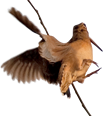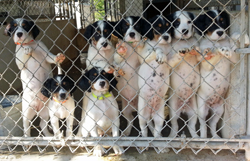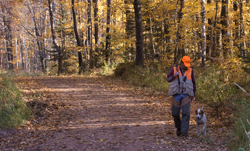Unproductive points
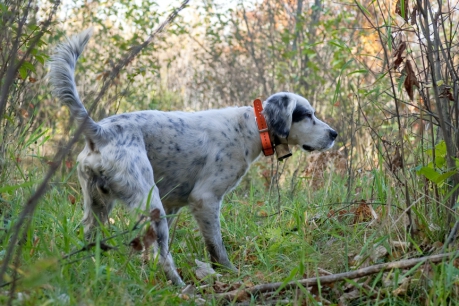
One of my best grouse dogs ever is Blue Shaquille (Houston x Blue Silk, 2004). He has a superb combination of instinct, nose, focus and tenacity which results in pinned grouse and very few unproductives.
It was a championship field trial run on sharp-tailed grouse. Both brace mates stood on point, independently, but in the same area. The handlers flushed extensively, relocated their dogs and flushed more. Neither handler could produce a bird so they released their dogs and continued down the course. As the gallery of riders passed through the exact area the dogs had just pointed, a single sharptail flushed.
I wasn’t competing that day but I was one of the judges. And one of those dogs was a multiple champion on wild birds, CH Centerpiece, owned and handled by seasoned Frank LaNasa.
What is an unproductive point?
When a dog points and no bird is flushed or seen to flush from the area, it is referred to as an unproductive point. Other terms such as unproductive, nonproductive and false point refer to the same situation.
Unproductive points will always occur—even to highly trained, experienced dogs like CH Centerpiece. Hopefully the following information will help with any frustration.
Why do unproductives occur?
Wild birds want to survive. They learn various avoidance techniques, especially when repeatedly pressured. Basically, wild birds are trying everything to outwit the dog.
These evasion tactics are confirmed by a five-year project undertaken by professors H. Lee Stribling and D. Clay Sisson of Auburn University in Alabama. The team used 254 radio-tagged, wild bobwhite quail coveys to determine how they behaved when encountered by dog and hunters.
Their findings on the causes of unproductive points are amazing.
• 58% caused by coveys running away from pointing dogs
• 31% attributed to wild flushes
• 11% sat tight and refused to flush
In addition, unproductives occurred in only 12% of the dogs’ encounters.
Unproductive points vary with the bird. Woodcock let the dog get close before pointing which results in fewer unproductives. Other species, such as ruffed grouse, require the dog to point from farther away, providing the dog with less scent and more opportunities to error. Other factors including age of the birds, cover type and weather conditions can effect on the number of unproductive points.
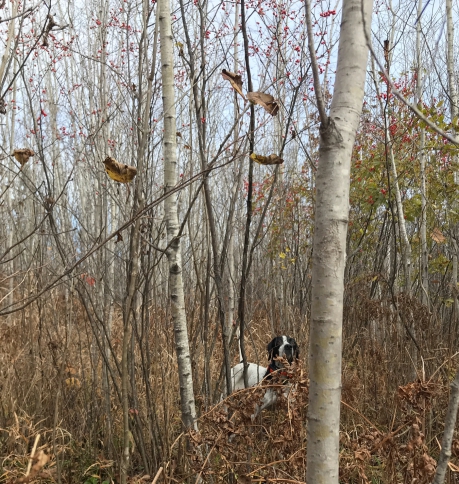
CH JTH Izzie (Westfall’s Black Ice x Northwoods Prancer, 2011) has successfully pointed hundreds of grouse and woodcock.
Good development is key.
What a dog gains by experience is not what you teach him, but what he teaches himself.
~ Dog Breaking, Major-General W. N. Hutchinson, 1865
While there is no way to avoid unproductive points, there are development and training methods that encourage a dog to point only when it is sure of the bird’s location. Young dogs should have plentiful opportunity to find, follow, point—and flush—birds. In other words, let the young dog learn on its own.
Experience is the best teacher and, in general, the more birds a dog contacts the better it will be. During these encounters, a dog learns invaluable lessons.
• How close to get before the bird flushes.
• How to differentiate where the bird is as opposed to where it has been.
• How to follow running birds.
• What foot and body scent smell like.
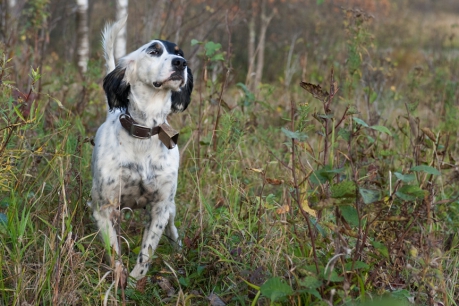
Northwoods Chardonnay (Blue Shaquille x Houston’s Belle’s Choice, 2009) inherited the best from both her parents and was an outstanding grouse dog.
Tips to help with too many unproductives.
If your dog is having excessive unproductive points, here are common reasons and tips to resolve them.
→ Over-cautiousness due to training problems.
Constant talking to the dog while it is working game is distracting and bothersome. Also severe corrections can be a problem. The dog doesn’t want to suffer the consequences of a mistake.
Tip: Be quiet when the dog is working game. Let the dog figure out how to handle birds without interference. Correct the dog only AFTER it flushes the bird and only enough to stop the chase. It might take more time for the dog to learn in this manner but you’ll have a better dog in the end.
→ Over-cautiousness due to genetics.
The dog lacks boldness toward birds because of its genes. Some dogs have too much point and a sub-par nose. Others have soft dispositions which can make them afraid of birds.
Tip: Move the dog (with your command or toot on a whistle) toward the bird. In other words, point it or bump it. Don’t make it a big deal if the dog bumps a few. Give the dog time to learn. This type of dog rarely develops a serious bumping problem. If the dog is young, let it mature a bit before more bird work.
→ Pointing off game.
Dogs can point off game like song birds, rodents, rabbits, deer or turkey. If the off game is flushed in front of the dog’s point, it’s not, technically, an unproductive. If nothing is produced, it can be hard to discern what the dog was pointing. You might see a deer bed or rabbit droppings but those could be coincidences, too.
Tip: If you know the dog is pointing off game, use correction. A verbal correction might be enough or you might need to escalate.
→ Foot scent or old scent.
Some dogs point foot scent or old scent. Under good conditions, dogs can smell ground scent that might be hours or even days old. If a dog is tired, it might put its head down more to where that scent is.
Tip: Move the dog (with your command or toot on a whistle) toward the bird. In other words, point it or bump it. For a tired dog, give it a rest.
→ Bad scenting conditions.
It might just be the scenting conditions that day. Remember the old saying about “wind from the east.”
Tip: Nothing you can do about this one. Be patient.
→ The dog doesn’t want to quit hunting.
I have seen dogs go on point for no reason other than it knows the hunt is ending. Sometimes I think it sees the truck.
Tip: It’s usually an act! Call the dog in and hope it’s not the proverbial truck bird!
Blue Shaquille and Northwoods Chardonnay photos by Chris Mathan, The Sportman’s Cabinet. JTH Izzie photo by Jeff Hintz.

